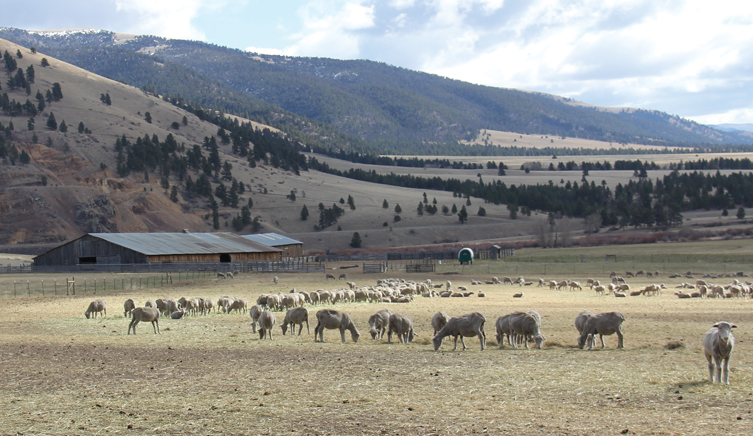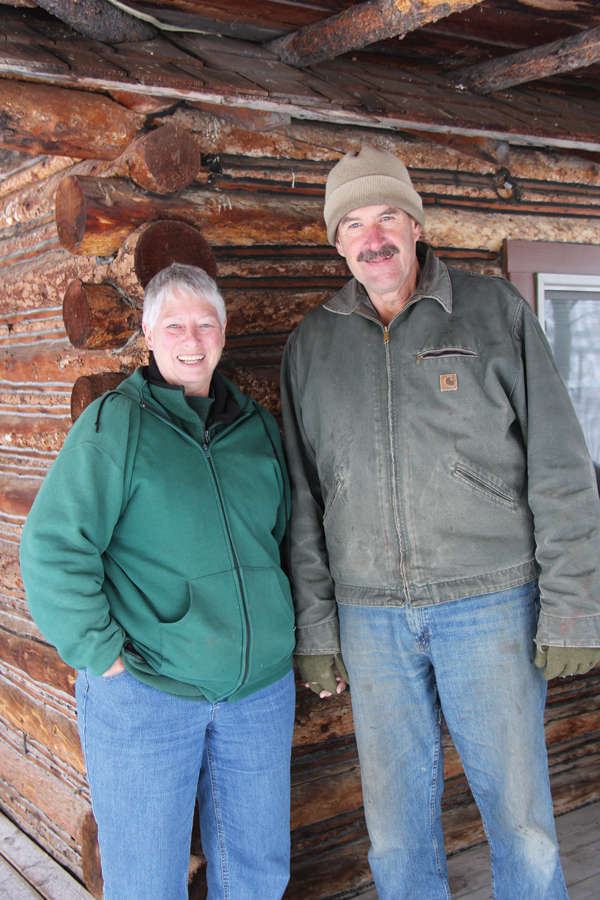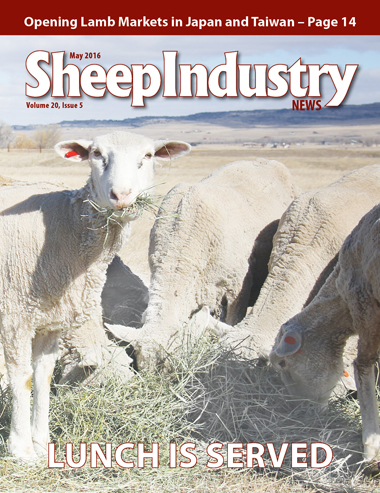Historic Sieben Ranch Thrives in Montana
KYLE PARTAIN
Sheep Industry News Editor
A clear, dark morning turns to cloudy skies and a spring snowstorm as I head north on I-15 out of Helena, Mont. I’d envisioned a sunny, crisp day as I left the hotel before dawn, but now all I can see is a light snow propelled at my front windshield with great force by typical Rocky Mountain winds. At times, it looks like that scene out of a sci-fi movie where spaceships make the jump to light speed.
 In reality, I’m headed back in time to a simpler place where life operates at a slower pace. You can’t hardly refer to the Sieben Ranch without throwing the word “historic” in front of it. As the ranch nears 120 years in the Sieben family, this is a distinction it holds in high regard.
In reality, I’m headed back in time to a simpler place where life operates at a slower pace. You can’t hardly refer to the Sieben Ranch without throwing the word “historic” in front of it. As the ranch nears 120 years in the Sieben family, this is a distinction it holds in high regard.
There are signs of this history everywhere you look. From the cemetery that contains the remains of the original ranch owner – Malcolm Clark – to the ranch house itself, I feel a sense of the resiliency needed to survive in what was once a remote location in central Montana. The ranch isn’t so remote these days, thanks to its own exit right off an interstate that can whisk modern-day occupants into Helena in less than half an hour.
Peruvian sheepherders are already out in the snow when I arrive. They’re preparing to trail a band of yearling ewes to the hay ranch in the Helena Valley. I’ve just made the drive in 20 minutes, but they’ll need three days on horseback to push the ewes to a temporary home that provides plenty of feed during late winter and spring. Of course, spring in Montana isn’t like spring in many parts of the country, as evidenced by this morning’s late March snowstorm.
The day before had been chilly and windy, but clear as family patriarch John Baucus took me on a whirlwind tour of the ranch and its vast landscape. While the morning snow is an unwelcome visitor, it hasn’t slowed the operation much. Making their first trip to the new range, the yearling ewes seem a little confused about where they are supposed to be headed this morning. But it doesn’t take long for the herders to push them down the ranch road, under the freeway overpass and onto the trail they’ll be following for the next three days. The only hiccup is a brief stop at the haystacks the sheep were supposed to be passing. A few quick movements by the border collies and we’re back on track.
Welcome to the historic Sieben Ranch.
Henry Sieben was already a respected Montana rancher when he purchased the Mart Mitchell Ranch in 1897. Born in Germany in 1846, he was just 5 years old when his family emigrated to America and settled in Illinois. At age 17, he headed west with friends and an older brother.
Having worked as a freighter in the Montana territory, he decided livestock was a more profitable profession after nursing worn-out oxen through the harsh winter and eventually selling them for a pretty penny to a local butcher the next spring, according to Henry Sieben: Legacy of Livestock and Land which was written by his granddaughter, Jean Baucus.
After getting their start in cattle, Henry and his brother, Leonard, dispatched another brother, Jacob, to California to purchase sheep. The animals were just starting to get a foothold in the territory, but prospered in the 1870s and the Siebens were among the area’s pioneers in the industry. Sheep have run in the family ever since.
Current ranch owner John Baucus is the great grandson of Henry Sieben. While his family lived in Helena, Mont., during the school year when he was growing up, he has fond memories of spending summers at the ranch each year.
“It was always fun to come out to the ranch,” he recalls. “I graduated college (Montana State University) in 1971 and came back here full time. I’ve been here ever since. I’ve never had a desire to live anywhere else. It’s nice to be on the ranch and away from town, but these days town really isn’t that far away if we need something.”
While sheep once dominated the landscape, the ranch has always had a mixture of sheep and cattle, and for good reason.
“Just with the terrain of the ranch, we’ve got a lot of areas that you’re never going to get a cow in to,” says Nina, John’s wife. “The sheep are the best way to manage the forage in those areas.”
“We’ve always thought of that grass the cattle don’t utilize as free grass, in a way,” John adds. “We enjoy working with the sheep and always have, but like anything, it’s price dependent. As long as we can pay the bills and make a little money, we’ll be in the business.”
With more than 100 years in the business, Sieben Ranch has proven itself within the sheep industry. But one constant in that time was a willingness to adapt. As they have been preparing to turn the ranch over to their son, John, they’ve looked into (and at times pursued) everything from the sale of timber and landscape rock to putting up cell towers, solar panels, windmills and drilling for fossil fuels in the past decade.
“At one time, we had the deepest dry hole in Montana,” the elder John says with a laugh. “But I’m kind of glad some of those things didn’t work out. We like the fact that we don’t have a bunch of roads running all over the ranch.”
To that end, herders do their daily work either on foot or horseback as John has stayed away from using the four-wheelers and side-by-sides that are common on many sheep ranches today.
“This country is very shaly,” he says, pointing up a nearby hill. “If you went up that in a four-wheeler, those tracks would be there for quite a while.”
Certain modern-day conveniences aren’t necessary thanks to the ranch’s herders. John and Nina say they’re fortunate to have the Peruvian help that they’ve hired in recent years. Rolo Ninahuanca Tocas is the sheep foreman and has obtained his U.S. citizenship since first joining the ranch. Many of the herders hired under his watch are relatives from the home country.
 “If we didn’t have them, we wouldn’t be in the sheep business anymore,” John says. “The guys we’ve had come over have been great to work with, and a lot of the credit for that goes to Rolo and the guys he recommends for hire.”
“If we didn’t have them, we wouldn’t be in the sheep business anymore,” John says. “The guys we’ve had come over have been great to work with, and a lot of the credit for that goes to Rolo and the guys he recommends for hire.”
The herders keep watch over 1,600 Rambouillet ewes that are usually divided into three flocks. Shearing takes place in early March and lambing follows a few weeks to a month later. A lone premature lamb sat under a heat lamp in the ranch’s massive lambing barn in mid-March.
“We used to be at 6,000 ewes, but we’ve been around 1,600 for a while now and it works,” John says. “Due to predation (we have them all) and past labor unavailability, we run less sheep. Now, we run more efficiently and weaning weights are up. That barn looks a lot bigger at our current numbers, so we’ve got a lot of space to put lambs in during bad weather.”
The ranch’s sheep numbers took a significant hit in the mid-1980s when John purchased out-of-state rams who brought foot rot into the ranch. Under quarantine, the couple treated the sheep, but numbers dropped off by at least a third thanks to the infestation.
“We have ranch records from the 1930s that show they were losing money on sheep, and the solution was to run more sheep. I think the range was overgrazed because that’s just the way they did it back then. But I think we’re at a pretty proficient level now with the grass and the facilities that we have on the ranch.”
Facilities at the ranch are first-class – including a historic shearing shed with ample room to bring sheep in under cover during the process. In addition, a goal of the ranch is to minimize complications that come from leasing federal lands. The Baucus family has purchased public lands within the ranch borders whenever they were available.
“Whether it’s state, BLM or Forest Service, we could see the fight that was coming with operating on public grounds,” John says. “We’re members of the Public Lands Council and we support what they are trying to do. I believe there are only three or four sheep operations in Montana that have forest permits.
The family holds a U.S. Forest Service permit, but uses it only for occasional daytime grazing. The sheep are then herded back onto ranch property to bed down each night. The private/public interface works well with grazing management.
“That eliminates a lot of problems when the sheep don’t spend the night on the permit,” John says. “Trading and buying our way out of most public lands was the best thing for us. People go out of this business for a lot of reasons, but losing permits is a real problem for ranchers in the west.”
Sieben Livestock Company, owned by John’s cousin Chase Hibbard, and based at another Sieben family ranch near Cascade, Mont., recently got out of the sheep industry – except for 40 sheep – as it begins to transition to the next generation. John doesn’t expect the same to happen at the Sieben Ranch.
“Our son has always been more into the cattle and doing some heavy equipment work,” John says. “But I think he sees the value in the sheep. They’re a big part of the history of this ranch.”


